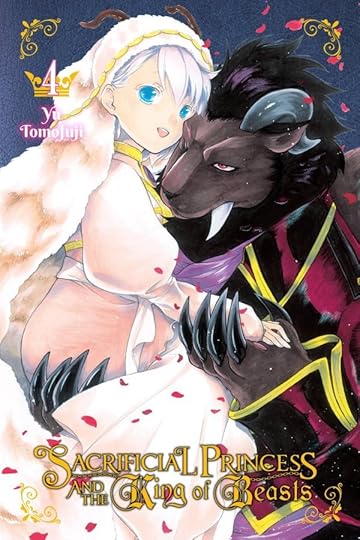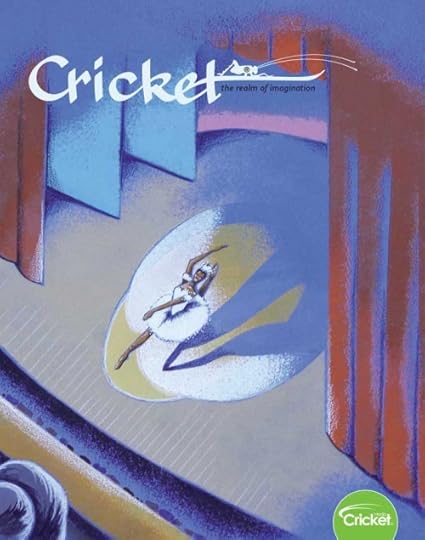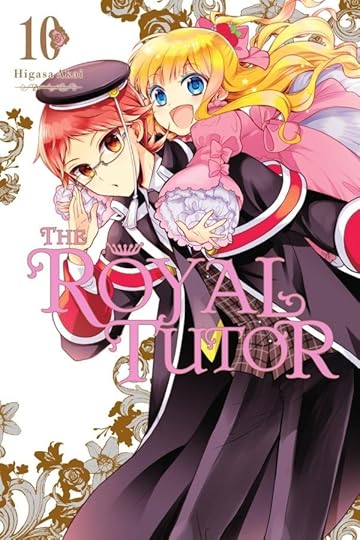S.Q. Eries's Blog, page 24
June 4, 2019
Manga Review: Sacrificial Princess and the King of Beasts Vol. #4
 The theme of love transcending appearances is a popular one in fairy tales, and Yen Press’ Sacrificial Princess and the King of Beasts fits that genre. The fantasy manga tells of the relationship between a girl and her beastly fiance, and you can read on for the review of Volume 4. (For reviews of other volumes, click here.)
The theme of love transcending appearances is a popular one in fairy tales, and Yen Press’ Sacrificial Princess and the King of Beasts fits that genre. The fantasy manga tells of the relationship between a girl and her beastly fiance, and you can read on for the review of Volume 4. (For reviews of other volumes, click here.)
Back Cover Blurb
Confronted with yet another challenge to prove she is worthy to become queen, Sariphi must now entertain the mysterious Duke Galois upon his visit to the palace. But will learning niceties and dance steps be enough to win over the duke, who is rumored to be a fearsome warrior with a burning hatred for all things human? Or has Sariphi been set up to fail her way out of the palace and the beast realm for good?
The Review
Now that the detour with Ilya is over, the story returns to Sariphi’s trials to become queen. Unlike the first trial, the second has nothing to do with magic. Rather, this one is about surmounting the prejudices humans and beastkind hold against each other. Duke Galois, a powerful lord and a military leader in the old wars against humans, has requested to meet the candidate for queen, and Chancellor Anubis declares that properly hosting this guest is Sariphi’s next test.
Previous volumes have hinted at Anubis’ opposition to Sariphi as queen. This volume indicates that he’s not merely advising the King against Sariphi but actively working to undermine her. While he has his reasons for doing so, his attempt to make Sariphi fail in a touchy political environment seems out of character for the otherwise sensible chancellor. In addition, Duke Galois’ visit is named as a trial when the palace learns that he’s coming; it’s not part of Anubis’ original “Trials to be Queen.” With Anubis adding tests as he pleases, the story seems as if it will wind up a struggle of Sariphi versus Anubis’ plots.
In this case, the ordinary girl must quickly learn the skills required of a beastperson queen. Watching friends Cy, Clops, and Amit bring her up to speed is fun, but when Sariphi actually has to greet the duke, Tomofuji-sensei draws Sariphi with a bizarre expression that makes her look hypnotized. And when Sariphi gives the duke a tour of the palace, the explanation of its layout is helpful but feels rather belated, considering we’ve been at this palace for four volumes now.
Much the way Naruto wins over his adversaries by sheer force of character, Sariphi does the same with the duke. However, the final outcome of this arc contains a major contradiction. At the outset, Leo tells Sariphi that the duke is stronger and more powerful than he is, and when Galois arrives, Anubis remarks that he’s someone indispensable to the kingdom. Yet at the end of the chapter, Anubis dismisses him as a person who can be easily replaced. While these sudden changes in opinion make for dramatic scenes, they don’t make a whole lot of sense.
Extras include embedded author’s notes about the characters and the bonus manga, “The Beast Princess and the Regular King.”
In Summary
The story shifts back to Sariphi proving her suitability to be queen consort with her second trial: acting as hostess to a hostile guest. This arc gives Sariphi a chance to show off her spunk, determination, and charm as well as the opportunity to dress up. However, like much of this series, the politics as well as the arbitrary addition of tasks to Sariphi’s trial list don’t make a whole lot of sense.
First published at the Fandom Post.
May 28, 2019
Manga Review: Hatsu*Haru Vol. 4
 Ah…high school romance. It is a staple of shojo manga, and Shizuki Fujisawa adds another title to this list with Hatsu*Haru. Read on for the review of Volume 4! (For reviews of previous volumes, click here.)
Ah…high school romance. It is a staple of shojo manga, and Shizuki Fujisawa adds another title to this list with Hatsu*Haru. Read on for the review of Volume 4! (For reviews of previous volumes, click here.)
Back Cover Blurb
School can’t teach you everything, especially when it comes to love! No matter how much a guy studies, it still won’t be enough to turn around his terrible luck with romance! Just as an apple can never return to the tree it fell from, is unrequited love destined to never be reciprocated?
The Review
Volume 3 ended with Kai essentially confessing his feelings to Riko. When Volume 4 continues the scene, that confession goes right over Riko’s head. Kai even takes the agonizing step of clarifying his feelings, but Riko still doesn’t get it. As a reader, this is a letdown because so much tension and emotion built up only for Kai’s efforts to go to waste because Riko is—as Ayumi puts it—“denser than a black hole.”
Thus, we have a lot of drama that results in absolutely no progression in Kai and Riko’s relationship. However, even though Riko doesn’t pick up on Kai’s feelings, Ayumi does. Deciding that Kai’s genuinely in love with Riko, she decides to give her support, and in no time, she winds up on Kai’s Romantic Endeavors Support Group with Miki, Tarou, and Takaya.
The Support Group gets their next big chance to push Riko and Kai together when Kai, Miki, Kagura, and Kiyo fail their exams. Tarou proposes a study camp at his family’s temple, and the same eight participants from the amusement park date join in. Although the lack of progress between Riko and Kai is frustrating, the interactions in the group scenes are quite fun. Having Ayumi actively take Kai’s side is also an improvement. Before, she was an outsider whose out-to-get-a-scoop tendencies were annoying and intrusive; now, she’s pretty much part of the circle and trading private jokes with the others.
There’s only so long Fujisawa-sensei can get away with Riko not picking up on Kai’s feelings, especially with the growing number of people aware of his crush. So Kai hits yet another bump in the road when he misinterprets a moment between Riko and Takaya and concludes that they’re mutually attracted. This leap is nearly as implausible as Riko’s ultra denseness, especially since the subject of Riko and Takaya’s conversation is Kai. Ultimately, it feels like an excuse to put Kai through the agony of imagining his crush with his best friend (although it is entertaining).
Extras include story-thus-far, embedded author’s notes, 10-page extra chapter, and afterword.
In Summary
Ayumi switches roles from being a snooping reporter to actively supporting Kai’s endeavors to win Riko’s heart. This adds an extra element of fun to the group efforts to bring Riko and Kai together. Unfortunately, the reasons preventing pair from getting on the same page are getting weirder and weirder, and I’m starting to feel more frustration toward their romance than anything else.
First published at the Fandom Post.
May 21, 2019
Manga Review: Dive!! Vol. 1
 With the 2020 Tokyo Olympics around the corner, there’s bound to be an interest in sports manga about Olympic hopefuls. Dive!! is one such title, and you can read on for the review of Volume 1!
With the 2020 Tokyo Olympics around the corner, there’s bound to be an interest in sports manga about Olympic hopefuls. Dive!! is one such title, and you can read on for the review of Volume 1!
Back Cover Blurb
Tomoki has long been passionate about the blink-of-an-eye performances that take place off the ten-meter diving platform. But as a member of the Mizuki Diving Club, he’ll need more than passion when his team’s lackluster record leaves them on the outs with their sponsors! With a new coach and a deadline to qualify for the Olympics in one short year, Tomoki and his teammates compete for glory with the fate of their diving club riding on their shoulders!
The Review
DIVE!! is a title that at first glance seems similar to the swimming anime Free! It’s a sports series whose main cast consists of young male athletes in swim wear. However, there are major differences. One, the main character, Tomoki Sakai is a second year in middle school. Two, there’s no teamwork dynamic to the plot. Most sports series center on a team sport (i.e., Haikyu!! and Kuroko’s Basketball) or the team version of a sport (i.e., Bamboo Blade and Tsurune). The set up for Dive!! is more along the lines of Yuri on Ice, where success and failure depends upon the individual, and although multiple athletes train in the same club, they’re ultimately rivals, not teammates.
The club that our main character trains at is the Mizuki Diving Club (MDC), a facility under the direct management of sporting goods manufacturer Mizuki. MDC has been operating at a loss, and the company’s new president is looking to shut it down. If MDC wants to stick around, it needs to produce results.
That’s where Kayoko Asaki steps in. She’s an America-trained diving coach who also happens to be the granddaughter of the previous Mizuki company president. Determined to keep the club open, she abruptly shows up as a new MDC coach and challenges its male divers to qualify for Japan’s Olympic Diving Team. The club’s star, high schooler Youichi Fujitani, immediately accepts the challenge. However, Tomoki, who’s a mediocre diver, is also inspired to strive toward that goal.
Tomoki falls under the category of the undiscovered talent. Because Coach Asaki recognizes his hidden potential and Tomoki is willing to endure her tough regimen, his abilities improve by leaps and bounds. While the diving training scenes are kind of interesting, Tomoki’s character arc is less compelling. He comes off as an uncaring jerk toward his girlfriend, and his overly emotional response to the backlash of other MDC divers (who have flagrantly rejected Coach Asaki’s training regimen) feels like drama for the sake of drama. As such, I don’t feel particularly invested in him as a character.
The other two MDC primary divers are fortunately a bit more interesting. Club star Youichi Fujitani is the son of divers, and although he lives up to his thoroughbred pedigree by winning competitions and inspiring MDC members, he resents the expectations heaped onto him. Meanwhile, Shibuki Okitsu is the club’s wild man. Unlike the others, he’s not interested in diving to compete or even diving in a pool. While this ocean diver is intriguing, he’s drawn more like a man in his prime than a high school teen.
If you’re familiar with the DIVE!! anime, the manga covers the same territory, but at a slower pace. This allows readers to get a better grasp of character arcs. For instance, the flashback to Youichi’s diving accident more clearly establishes his bitterness than the anime does. In addition, the frame by frame illustrations break down the split second diving acrobatics that my eyes couldn’t keep up with in the TV series.
Extras include the first four pages in color and translation notes.
In Summary
If you’re interested in learning about the sport of high diving, this manga will teach you a few things. If you enjoy illustrations of fit young men in Speedos, you’ll get that, too. While the main character isn’t particularly lovable, this story of young athletes striving to make the Olympic Team does have timely appeal with the 2020 Tokyo Olympics fast approaching.
First published at the Fandom Post.
May 15, 2019
Just Published: Cheonson and the Admiral!
2019 has been a gratifying year. Three months ago, my Cultural Revolution story Hidden Heritage was printed in Cricket Magazine. This month, Cricket published another story of mine: Cheonson and the Admiral!
Click here for the link to the magazine!
Like Hidden Heritage, this is a historical; unlike Hidden Heritage, Cheonson and the Admiral is set in 16th century Korea. The aforementioned admiral is Yi Sun-Sin, a brilliant commander who turned the tide against the invading Japanese in the Imjin War (23 wins in 23 naval battles!). As for Cheonson, he was a young cowherd who brought Yi information critical to the Battle at Hansan.
Although Yi’s a national hero to Koreans, he’s relatively unknown in the West, and I have my husband to thank for introducing me to the admiral. He saw a feature film about Yi (The Admiral: Roaring Currents) during a flight to Korea, and it so impressed him he came home gushing about Yi’s trademark turtle ships. So when I saw the “Make a Splash” theme on Cricket’s Call for Submissions website, I figured Yi’s story was worth telling.
However, the tricky thing about writing Cheonson was the lack of reference materials. Korean texts about Yi and the Imjin War abound, but there’s not a whole lot in English. Pretty much only university collections have anything on the subject, and fortunately, Stanford University’s library has a limited public access policy so I was able to see the few books they had about Yi.
 I was also fortunate to have friends help me with story details (thanks, Dorthy and Esther!). I’m of Chinese descent so I had a level of comfortability depicting the Bao family of Hidden Heritage. Cheonson and the Admiral was definitely outside my culture, and I was grateful that my Korean-American friends and their Korean-born parents were willing to vet out my portrayal of Koreans in the Imjin War.
I was also fortunate to have friends help me with story details (thanks, Dorthy and Esther!). I’m of Chinese descent so I had a level of comfortability depicting the Bao family of Hidden Heritage. Cheonson and the Admiral was definitely outside my culture, and I was grateful that my Korean-American friends and their Korean-born parents were willing to vet out my portrayal of Koreans in the Imjin War.
I’m thrilled Cheonson and the Admiral made it into the world, and I hope you get to enjoy it in Cricket’s May/June 2019 issue!
May 14, 2019
Light Novel Review: Saga of Tanya the Evil Vol. #04
 The Saga of Tanya the Evil anime was a surprise favorite for me in 2017. With a title like that, I was almost too scared to give it a try, but conniving little Tanya turned out to be nothing like I anticipated. Yen Press has released Volume 04 of the light novel adaption, and you can read on for the review. (For reviews of other Tanya the Evil works, click here.)
The Saga of Tanya the Evil anime was a surprise favorite for me in 2017. With a title like that, I was almost too scared to give it a try, but conniving little Tanya turned out to be nothing like I anticipated. Yen Press has released Volume 04 of the light novel adaption, and you can read on for the review. (For reviews of other Tanya the Evil works, click here.)
Back Cover Blurb
A devil wanders the battlefield in the guise of an adorable young child and her name is Tanya Degurechaff! After returning from the sandy southlands, Tanya receives an incredibly suspicious order from headquarters to embark on a training exercise. In reality, command has sent her on a covert mission to initiate a border conflict with the Federation. Soon the Empire finds itself embroiled in another fight it cannot back down from, even if it means making the entire world their enemies!
The Review
Having fought on the Empire’s north, south, and west fronts, Tanya now gets sent east. The Federation is the one neighbor that has maintained peace with the Empire, so when the 203rd Aerial Mage Battalion gets yanked from the Southern Continent and receive orders to infiltrate the Federation under the pretext of a training exercise, it’s clear trouble’s brewing.
In previous conflicts, the narrative generally described the war’s outbreak and provided a heap of commentary before throwing Tanya into that battlefield to participate. This time she’s actually a witness to the outset of the war. And because the Federation and the Empire are being highly secretive—even to their own officers, the tension in the opening chapter is wonderful.
Once the fighting breaks out, things get even better. Against previous adversaries, Tanya never harbored personal hatred; taking them down is just her job. The Communists, however, fall into a completely different category. Our former salaryman and believer in market values loathes Communists, and seeing Tanya get so het up about an enemy is a fascinating change. The lengths she’ll go to undermine the Commies are surprisingly extreme and not only from a military tactical standpoint. Suffice to say, her raid on the Federation capital is a thrill to read.
I am guessing that Zen-sensei himself is also not a fan of Communists because he depicts the Federation as the worst type of Stalinist regime. Not only is it a state whose soldiers are as terrified of the ruling regime as they are of enemy armies, but Comrade Loria, the dictator’s right hand man, is a pervert with no redeeming qualities. He’s definitely a villain with a truly icky POV.
After the initial clash with the Communists, Zen-sensei switches back to his usual style of over explaining the rationale behind everything. In Chapter III, Tanya and her officers spend 9 pages debating whether or not they should rescue forces trapped at Tiegenhoff, and the text describing the actual mission only takes a page. Fortunately, he’s more generous with his play-by-play of a daring combat-search-and-rescue in Commonwealth Territory.
In contrast to Tanya’s brilliant individual victories, the fortunes of her country continue to decline. As result, we get a refrain of an earlier theme: efforts intended to snag a cushy desk job result in yet another assignment on the front lines. In spite of Zen-sensei’s long-winded prose, the twists and turns of the plot remains compelling, and I look forward to the next volume.
Extras include map and fold-out illustration in color; appendixes explaining military strategy and history timeline; author afterword; and six black-and-white illustrations.
In Summary
A new front breaks out for the already beleaguered Empire. Previously, we’ve had precious little about the Federation to the east; now the Stalinist leadership clashes head to head with Tanya, who absolutely detests Communists. If you’ve stuck with the series this long, Tanya’s passion against this new adversary will be a fun and engaging new element in this military chronicle.
First published at the Fandom Post.
May 7, 2019
Manga Review: Spice and Wolf Vol. #16
 Spice and Wolf is a wildly popular light novel series that has spawned off an anime, an Internet radio show, and a manga series. While its European medieval setting is typical of high fantasy, this series has a unique bent to it. Rather than swordfights and magic, the plot focuses on economics, trade, and peddling in a way that skillfully blends adventure and romance.
Spice and Wolf is a wildly popular light novel series that has spawned off an anime, an Internet radio show, and a manga series. While its European medieval setting is typical of high fantasy, this series has a unique bent to it. Rather than swordfights and magic, the plot focuses on economics, trade, and peddling in a way that skillfully blends adventure and romance.
Yen Press has released the final volume of the Spice and Wolf manga, and you can read on for the review. (For my reviews of previous Spice and Wolf releases, click here.)
Back Cover Blurb
The journey of the wisewolf and the traveling merchant comes to a riveting conclusion! Lawrence and Holo have thrown in their lot with Hilde and those loyal to the original mission of the Debau Company. Will they be able to wrest back control of the territory from the radical contingent?
The Review
It’s obvious from the cover illustration that this series will end with a joyful wedding. As if to emphasize that point, the title page is a full-color illustration of Holo in a second wedding outfit. All told, the artist draws Holo in four different wedding dresses in this final volume. It’s a visual treat for the romantic types and assurance to the readers that things will end well in spite of the dire situation in the book’s opening chapter.
Despite Holo’s dramatic intervention at the close of Volume 15, things remain dicey for our main characters and the Myuri mercenaries. Although they’ve managed to withdraw into Svernel, the town head Millike (who also happens to be a non-human) does not want to get mixed up in the Debau Company’s internal fight. If an armed force comes to his gates, he’s quite willing to hand over Hilde and the Myuri Company to preserve the peace. Worse, the wounds Lawrence sustained were serious enough to threaten his life.
With the Debau radical faction’s armed forces en route to Svernel, our heroes are stuck. However, Lawrence and Holo are not so much involved in the conflict as they were forcibly dragged in by Hilde’s scheme. As such, Holo and Laurence are offered the opportunity to run away from the mess while the rest face the consequences. It’s a heart-wrenching decision for the couple, but Holo makes her choice decisively. Despite the way she’s teased and harassed Lawrence throughout the series, he is what’s most important to her, and her concern for his well-being gets emphasized over and over in these chapters.
But as with all Spice and Wolf predicaments, our couple finds a way out. In this case, it’s Lawrence exposing the secret behind the Debau radical faction’s cash reserves. However, the narrative rushes through the thought process by which he unravels their very complicated scheme. In addition, it draws in elements from several volumes ago, which I’d mostly forgotten about. As such, the abruptness of Lawrence’s revelation made his moment of inspiration feel like a deus ex machina. However, if you don’t care about such details and are more interested in watching Holo and Lawrence team up against the bad guy, you will be plenty satisfied.
The final two chapters are dedicated to Holo and Lawrence’s wedding five years later. Like a lot of conclusions, it tries to fill us in on what’s happened to everyone in the cast. Unfortunately, it glosses over a lot, like the reason behind shepherdess Norah’s new occupation as a town priest (if you want the details behind that, you’ll have to read the novels.) However, it does do a good job of depicting Holo and Lawrence’s mutual affection and foreshadowing the happiness that lies ahead of them.
Extras include title illustration in color, the bonus manga “Rainbow Music and Wolf,” and afterword.
In Summary
As they say, it’s darkest before the dawn. Holo, Lawrence, and their companions wind up with their backs against a wall in Svernel, but Lawrence saves the day by exposing the Debau radicals’ crooked practices. The explanation of the economics behind it comes in a complicated, bewildering rush, but romance fans will be gratified to see this incident spur Holo and Lawrence to commit to one another.
First published at the Fandom Post.
April 30, 2019
Manga Review: Sword Art Online: Progressive Vol. 007
 Sword Art Online was undoubtedly one of the most popular anime of 2012. Based upon a series of light novels by Reki Kawahara, SAO’s near-future characters, gorgeous fantasy setting, and life-or-death stakes drew an enthusiastic fan following. Yen Press has released Volume 7 of the Sword Art Online: Progressive manga adaption, and you can read on for the review. (For my review of other Sword Art Online manga, click here.)
Sword Art Online was undoubtedly one of the most popular anime of 2012. Based upon a series of light novels by Reki Kawahara, SAO’s near-future characters, gorgeous fantasy setting, and life-or-death stakes drew an enthusiastic fan following. Yen Press has released Volume 7 of the Sword Art Online: Progressive manga adaption, and you can read on for the review. (For my review of other Sword Art Online manga, click here.)
Back Cover Blurb
The mysterious player Morte has manipulated the human guilds into fighting BOTH side of the Elf War! While Kirito challenges him to a duel, Asuna has an important task of her own: steal the battle plans from the Forest Elves so she can end this quest before it turns deadly. They need to stop the war before someone loses their life–permanently!
The Review
Volume 006 was devoted to a lot of complicated set up with the Elf Quest and the newly formed guilds. Volume 007 presents the payoff in the form of three simultaneous fights: the Dragon Knights Brigade vs. the Aincrad Liberation Squad; Asuna/Kizmel vs. the Falconer; and Kirito vs. Morte. If you like action, swordplay comprises most of this volume. If it was animated (which I really wish it was), the entire contents would probably take up only two episodes.
Interestingly, the fight involving the most humans (the guild fight) gets the least attention, and Kirito’s one-on-one with the schemer who pitted the guilds against each other is arguably the most intense. Their duel is thrilling with some really exciting perspectives of the action. In addition to the players’ abilities, the fight also reveals their character. Morte is no doubt a precursor to the PK groups that would later plague Aincrad, and he’s cast in the worst possible light. Not only does he have a twisted personality and use underhanded tricks, he actually possesses reasonably powerful skills—which he prefers to use against other humans rather than game bosses. As for Kirito, Morte’s egging shows just how strongly he feels about Asuna.
Asuna’s fight also shows how strongly she feels—about Kizmel. Her affection for the NPC goes beyond common gamer sense. For Asuna, their battle against the Falconer is as much about helping Kizmel exact retribution for her sister’s death as it is completing the ”Infiltration” quest. And her devotion to the dark elf results in some surprising responses from Kizmel, which drives home the point that SAO is no ordinary game.
After all that fighting, things resolve happily all around, and even though the Elf Quest had nothing to do with beating the Third Floor Boss, the players safely complete the third level in the span of a few pages. This rushed ending is probably because a different artist, Shiomi Miyoshi, is taking over the Progressive manga starting with the fourth floor. Although Himura-sensei’s artwork has been heavy on the fanservice (even the guild members get fanservice in this volume), his depiction of the SAO world has been engaging overall, and I hope Miyoshi-sensei continues in that vein (minus the extraneous panty shots).
Extras include the first page printed in color and messages from various SAO collaborators.
In Summary
Himura-sensei delivers an action-packed conclusion to the Elf Quest. Between the dynamic illustrations and mid-battle surprises, the swordfights are a thrill to behold. Fans of happy endings will also be satisfied at how the arc wraps up. It’s a little rushed toward the end, especially the pace at which third floor gets cleared, but that’s probably because another artist is taking over the series. I don’t know if it will continue as part of this series or launch as a new one, but I look forward to Shiomi Miyoshi-sensei’s version of the Progressive world.
First published at the Fandom Post.
April 23, 2019
Manga Review: The Royal Tutor Vol. 10
 Rich, handsome young men, each with his own distinct personality…this type of bishounen cast is a staple in shojo manga. And if you like yours with a generous helping of chibi humor, you should definitely check out Higasa Akai’s The Royal Tutor. Read on for my review of Volume 10. (For my reviews of other volumes click here.)
Rich, handsome young men, each with his own distinct personality…this type of bishounen cast is a staple in shojo manga. And if you like yours with a generous helping of chibi humor, you should definitely check out Higasa Akai’s The Royal Tutor. Read on for my review of Volume 10. (For my reviews of other volumes click here.)
Back Cover Blurb
Three of the princes have left home to study away from the castle and the guidance of Heine, but Leonhard remains, still under the strict observation of the Royal Tutor! Beneath the surface of everyday life lies the fierce will to fight for the right to the throne! With change all about them, now comes the time to grow and learn…
The Review
With his brothers leaving home, Leonhart’s the sole prince left at the palace. As such, he appears in most of Volume 10’s chapters. However, the volume begins with an interesting family gathering in the wake of so many departures: The Queen Mother summons Adele, Leonhart, and Eins for a tea party.
The Queen Mother’s motivation is entirely innocent; she simply wants quality time with her grandchildren. Neither Leonhart nor Eins can deny their grandmother her wish. But neither can they deny their true natures, so the two can’t help but pick at each other’s faults. And because Leonhart is involved, their sniping takes on a distinctly childish tone.
The princes’ bickering is a foregone conclusion, but what is a surprise is a private exchange between Heine and Count Rosenberg, who are also present at the tea party. Up till now, Count Rosenberg has always played the part of a cool-headed conniver. However, when Heine bluntly states that the king deems Eins unfit for the throne, the count responds with uncharacteristic emotion. Although the series’ focus has been on the flaws of the younger princes, this lays the groundwork for scrutiny of Eins’ character, which has previously been assumed perfect.
But Akai-sensei doesn’t delve into that immediately. Instead she shifts the focus back to the other princes. Licht may have left the palace, but he’s still in town, which means Heine remains his tutor. Independent living means Licht requires a different education, and his cooking lesson in “A Lifestyle Lesson” is reminiscent of their overnight stay at the boss’ quarters. Next we get a glimpse of Bruno adjusting to life in Orosz, a Russia-like country, where his greatest challenge is getting along with his academic peer Smerdyakov. Then poor Kai only gets a passing mention before the focus returns to Leonhart at the palace.
The last three chapters have the White Lily prince in three separate situations: a brush with an old tutor at the library, a visit to Licht’s workplace, and a wardrobe quandary with Adele. Although his simple-mindedness is the source of humor for these scenes, it is thankfully not the primary focus. Rather, these chapters show where he’s been and point toward the type of person he now aspires to be. Which is a relief because Leonhart’s stupidity can only carry the plot so far.
Extras include bonus manga on the inside cover and first page printed in color.
In Summary
If you like Leonhart, you’ll like this installment. Although we get updates on the other princes, Leonhart dominates this volume. His academic incompetence continues to be the source of jokes, but this volume focuses less on his stupidity and more on his changing character. And speaking of character, Akai-sensei inserts some very interesting scenes that raises questions about the fatal flaw to Prince Eins’ character.
First published at The Fandom Post.
April 16, 2019
Manga Review: Tokyo Tarareba Girls Vol. #02
 The midlife crisis isn’t just a popular trope in American entertainment; it’s the subject of manga also, and Akiko Higashimura, creator of Princess Jellyfish, delves into the woes of 30-something singles with her series Tokyo Tarareba Girls. Read on for the review of Volume 2! (For reviews of other volumes, click here.)
The midlife crisis isn’t just a popular trope in American entertainment; it’s the subject of manga also, and Akiko Higashimura, creator of Princess Jellyfish, delves into the woes of 30-something singles with her series Tokyo Tarareba Girls. Read on for the review of Volume 2! (For reviews of other volumes, click here.)
Back cover Blurb
“What if I had done this…” “What if I could just..” After years spent spinning these what-if tales, Rinko woke up to find herself a 33-year-old woman with rusty romantic instincts. Even at that age, she doesn’t know her next move. She doesn’t even know what kinds of relationships are acceptable anymore. Strap in for this seriously real thirty-something fumbling-in-the-dark love(?) story!!
The Review
In one of the volume’s bonus manga, Higashimura-sensei describes her colleagues’ desperate and despairing reactions to this series. In fact, a friend calls it as a “horror comic.” That’s because, even if Higashimura-sensei’s intention is to create comedy, the circumstances that she’s created for her characters are pretty depressing. It doesn’t help that Rinko’s codfish milt and liver (which her friends also start to see) make commentary that’s generally caustic and dismal.
At the end of Volume 1, I expected some kind of relationship to emerge between Rinko and Key. However, she wakes up alone after their one night stand. And not only does he leave that morning without a word, he has the gall to criticize her when she complains to her friends about it.
Clearly, sex has not changed things between them. As a result, Rinko harbors insecurity and self-doubt. At this point, it’d be easy to write Key off as a heartless bastard, but then Koyuki discovers that he lost someone he dearly cared about. While this makes Key more human, the knowledge that he holds greater affection for a woman who’s dead is an even bigger blow to Rinko’s self-confidence.
To make things worse, her friends join in the can’t-find-a-decent-guy misery. After reminiscing about the unsuccessful musician she broke up with five years ago, Kaori discovers he’s hit it big—and is dating a young model. But even though Kaori knows she’s lost her chance with him, she sleeps with him anyway. As for Koyuki, she falls for a salaryman, and when he tells her point blank he’s married, she starts an affair without any hesitation.
It’s a grim world for these middle aged women. The moments when they gripe about their problems are supposed to be funny, but they’re so bitter and vicious that it’s painful to read.
Extras include embedded cultural footnotes, two bonus manga, and translation notes.
In Summary
Higashimura-sensei creates a harsh reality for her characters. Instead of launching into a complicated relationship between an older woman and a younger man, we get no relationship at all when Key leaves Rinko without a word after their one-night stand. While she reels from his cold treatment, her two girlfriends wind up in dead-end relationships. Pathetic? Yes. Funny? Not really.
First published at The Fandom Post.
April 9, 2019
Light Novel Review: Wolf and Parchment: New Theory Spice and Wolf Vol. 3
 Holo and Lawrence of the Spice and Wolf light novel series have reached their happy ending, but for those who haven’t gotten enough of the Spice and Wolf world, creator Hasekura has a spinoff series: Wolf and Parchment. Read on for the review of Volume 3.
Holo and Lawrence of the Spice and Wolf light novel series have reached their happy ending, but for those who haven’t gotten enough of the Spice and Wolf world, creator Hasekura has a spinoff series: Wolf and Parchment. Read on for the review of Volume 3.
Back Cover Blurb
The companion of the young man who wishes to become a priest, Col, is the daughter of the wisewolf, Myuri, and she urges him to make her his wife. After leaving the pirate islands, the two get caught up in a storm and arrive the port town of Desarev in the Winfiel Kingdom. In this town, where the Church lies dormant, Col is called “The Twilight Cardinal” and is treated like a savior. He also has to face Myuri’s unrequited love, so he forbids her from calling him “Brother,” and tries to change their relationship. Before them appears a merchant girl who calls herself Ilenia. She is the embodiment of a sheep and asks them to help her with some “big plans!”
The Review
The world of Wolf and Parchment/Spice and Wolf is predominantly one of the humans. Even though the main cast includes nonhumans, the narrative treats them like creatures whose era is long past. As such, whenever the occasional new nonhuman enters the story, they’re generally striving to survive as a member of human society.
Volume 3 changes this dynamic. It begins with a storm forcing Myuri and Col to land in Winfiel’s town of Desarev. There, Col sees firsthand how Winfiel’s conflict with the Church has impacted ordinary citizens. As with so many stories in this series, religion and economics loom large in the details. In this case, because the corrupt Church has retreated from the kingdom, the populace reaps material benefits but also spiritual insecurity. On top of that, Winfiel’s king is demanding churches pay taxes as retribution. And it’s in the midst of this strife that Col and Myuri chance upon Ilenia, who’s the embodiment of a sheep, and rumors of the Moon-Hunting Bear.
In the Spice and Wolf series, the Moon-Hunting Bear was only found in dusty manuscripts, and I assumed it died like so many other creatures of legend. However, Ilenia tells of a recent naval expedition that was almost completely destroyed by a monster in a land far to the west. She’s convinced it’s the Moon-Hunting Bear. Moreover, she views that western land as a place where nonhumans can live freely.
At this point, the story takes on elements of the Age of Exploration in addition to aspects of the Reformation. On top of that, the one striving to go to the new world is a sheep girl who wants to create a county where beings like her can live in their true forms. This sounds like a massive hodgepodge, but Hasekura-sensei links everything such that the narrative not only makes sense, it sheds extra light upon previous actions of the Church and the Winfiel royal family. In addition, it also draws several non-human characters, new and old, into the narrative.
As such, this volume is a delightfully multilayered read from beginning to end. Even the troublesome element of Myuri’s obsessive crush is addressed satisfactorily when Col makes her realize that she’s unable to address him by any name except “Brother.” The only problematic detail is that smoke inhalation isn’t an issue in the dramatic final scene, but that aside, Hasekura-sensei combines a host of disparate elements into a cohesive, engaging story.
Extras include the first eight pages printed in color, world map, seven black-and-white illustrations, and afterword.
In Summary
Amid growing political and religious tensions come rumors of a monster to the far west. The reemergence of the name of the Moon-Hunting Bear seems abrupt in a very human conflict, but Hasekura-sensei weaves the story such that the interests of humans and nonhumans are intertwined, although not aligned. This brings to light a whole new aspect of the conflict between the Church and Winfiel and builds anticipation for the next step in Col and Myuri’s journey.
First published at the Fandom Post.



